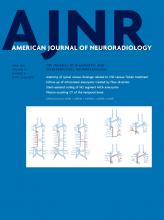Research ArticleInterventional
Follow-up of Intracranial Aneurysms Treated by Flow Diverters: Evaluation of Parent Artery Patency Using 3D-T1 Gradient Recalled-Echo Imaging with 2-Point Dixon in Combination with 3D-TOF-MRA with Compressed Sensing
J. Burel, E. Gerardin, M. Vannier, A. Curado, M Verdalle-Cazes, N. Magne, M. Lefebvre and C. Papagiannaki
American Journal of Neuroradiology April 2022, 43 (4) 554-559; DOI: https://doi.org/10.3174/ajnr.A7448
J. Burel
aFrom the Departments of Radiology (J.B., E.G., A.C., M.V.-C., N.M., M.L., C.P.)
E. Gerardin
aFrom the Departments of Radiology (J.B., E.G., A.C., M.V.-C., N.M., M.L., C.P.)
M. Vannier
bBiostatistics (M.V.), Rouen University Hospital, Rouen, Normandie, France
A. Curado
aFrom the Departments of Radiology (J.B., E.G., A.C., M.V.-C., N.M., M.L., C.P.)
M Verdalle-Cazes
aFrom the Departments of Radiology (J.B., E.G., A.C., M.V.-C., N.M., M.L., C.P.)
N. Magne
aFrom the Departments of Radiology (J.B., E.G., A.C., M.V.-C., N.M., M.L., C.P.)
M. Lefebvre
aFrom the Departments of Radiology (J.B., E.G., A.C., M.V.-C., N.M., M.L., C.P.)
C. Papagiannaki
aFrom the Departments of Radiology (J.B., E.G., A.C., M.V.-C., N.M., M.L., C.P.)

References
- 1.↵
- Nelson PK,
- Lylyk P,
- Szikora I, et al
- 2.↵
- Kallmes DF,
- Hanel R,
- Lopes D, et al
- 3.↵
- Brinjikji W,
- Murad MH,
- Lanzino G, et al
- 4.↵
- Dandapat S,
- Mendez-Ruiz A,
- Martínez-Galdámez M, et al
- 5.↵
- Oishi H,
- Fujii T,
- Suzuki M, et al
- 6.↵
- O'Kelly CJ,
- Spears J,
- Chow M, et al
- 7.↵
- 8.↵
- 9.↵
- Zhang X,
- Lv N,
- Wang C, et al
- 10.↵
- 11.↵
- Soize S,
- Gawlitza M,
- Raoult H, et al
- 12.↵
- 13.↵
- Becske T,
- Brinjikji W,
- Potts MB, et al
- 14.↵
- Deutschmann HA,
- Wehrschuetz M,
- Augustin M, et al
- 15.↵
- 16.↵
- Attali J,
- Benaissa A,
- Soize S, et al
- 17.↵
- Boddu SR,
- Tong FC,
- Dehkharghani S, et al
- 18.↵
- 19.↵
- McGuinness BJ,
- Memon S,
- Hope JK
- 20.↵
- 21.↵
- Kaufmann TJ,
- Huston J,
- Mandrekar JN, et al
- 22.↵
- 23.↵
- 24.↵
- Landis JR,
- Koch GG
In this issue
American Journal of Neuroradiology
Vol. 43, Issue 4
1 Apr 2022
Advertisement
J. Burel, E. Gerardin, M. Vannier, A. Curado, M Verdalle-Cazes, N. Magne, M. Lefebvre, C. Papagiannaki
Follow-up of Intracranial Aneurysms Treated by Flow Diverters: Evaluation of Parent Artery Patency Using 3D-T1 Gradient Recalled-Echo Imaging with 2-Point Dixon in Combination with 3D-TOF-MRA with Compressed Sensing
American Journal of Neuroradiology Apr 2022, 43 (4) 554-559; DOI: 10.3174/ajnr.A7448
0 Responses
Follow-up of Intracranial Aneurysms Treated by Flow Diverters: Evaluation of Parent Artery Patency Using 3D-T1 Gradient Recalled-Echo Imaging with 2-Point Dixon in Combination with 3D-TOF-MRA with Compressed Sensing
J. Burel, E. Gerardin, M. Vannier, A. Curado, M Verdalle-Cazes, N. Magne, M. Lefebvre, C. Papagiannaki
American Journal of Neuroradiology Apr 2022, 43 (4) 554-559; DOI: 10.3174/ajnr.A7448
Jump to section
Related Articles
Cited By...
This article has not yet been cited by articles in journals that are participating in Crossref Cited-by Linking.
More in this TOC Section
Similar Articles
Advertisement











